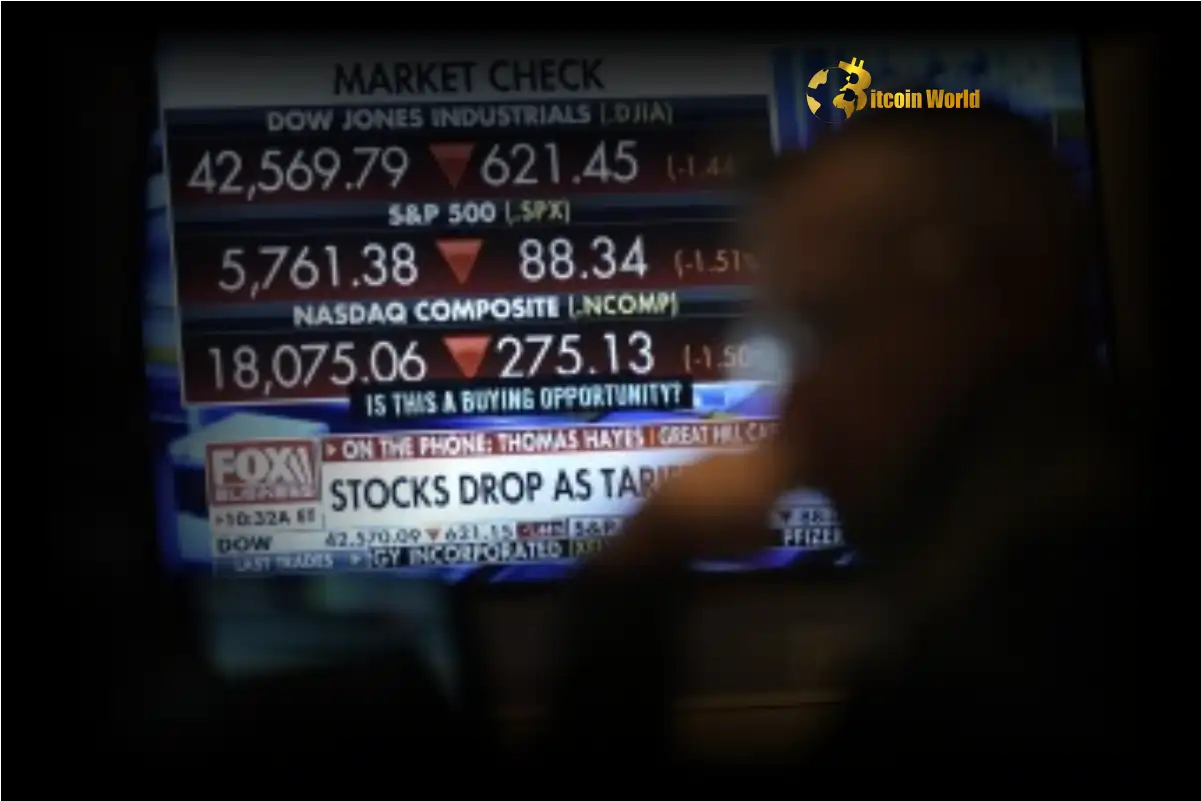Shocking Stock Market Crash: S&P 500, NASDAQ, and Dow Plunge – What’s Next?
0
0

Brace yourselves, investors! The U.S. stock markets have opened in a sea of red, sending shockwaves through Wall Street and sparking concerns about a potential broader economic slowdown. The speed and severity of today’s downturn have caught many off guard, leaving investors scrambling to understand what’s happening and, more importantly, what to expect next. Is this the beginning of a deeper stock market crash? Let’s dive into the details.
Unprecedented Market Downturn: A Sea of Red Across the Board
The opening bell today signaled not just a lower open, but a significant and alarming market downturn. All major indices are deep in negative territory, with technology stocks taking a particularly hard hit. Here’s a snapshot of the key market indicators at the opening:
| Index | Percentage Change |
|---|---|
| S&P 500 | -3.36% |
| NASDAQ | -4.58% |
| Dow Jones Industrial Average | -2.69% |
These are not just minor dips; these are substantial drops indicating strong selling pressure and a significant shift in investor sentiment. Such widespread declines across the board suggest a confluence of factors are at play, creating a perfect storm for market volatility.
Decoding the S&P 500 Plunge: What’s Fueling the Sell-Off?
The S&P 500, often considered the benchmark for the overall U.S. stock market, is down over 3%. This sharp decline raises critical questions about the health of the economy and the near-term prospects for corporate earnings. Several factors could be contributing to this dramatic sell-off:
- Inflation Fears Reignite: Persistent inflation continues to be a major concern. Recent economic data may be suggesting that inflation is proving stickier than initially anticipated, forcing investors to reassess the likelihood of more aggressive interest rate hikes by the Federal Reserve.
- Interest Rate Hikes Loom Larger: The prospect of continued and potentially larger interest rate hikes is weighing heavily on investor sentiment. Higher interest rates increase borrowing costs for companies, potentially slowing down economic growth and impacting corporate profits.
- Geopolitical Uncertainty: Global events and geopolitical tensions always add an element of risk to the markets. Uncertainty in the global landscape can lead investors to pull back from riskier assets like stocks.
- Earnings Season Concerns: While earnings season is underway, forward-looking guidance from companies may be painting a less optimistic picture. Concerns about future earnings growth in a potentially slowing economy are likely contributing to the negative market reaction.
NASDAQ’s Tech Tumble: Growth Stocks Under Pressure
The NASDAQ Composite, heavily weighted in technology stocks, is experiencing an even steeper decline, falling nearly 5%. This is not surprising, as growth stocks, particularly in the tech sector, are often more sensitive to changes in interest rates and economic outlook. Here’s why the NASDAQ is taking a bigger hit:
- Higher Valuation Sensitivity: Tech stocks, often trading at higher valuations based on future growth expectations, are particularly vulnerable when interest rates rise. Higher rates make future earnings less valuable in present terms, leading to valuation compression.
- Growth Slowdown Fears: Concerns about a potential economic slowdown are particularly worrying for high-growth tech companies. If economic growth slows, the rapid growth rates projected for many tech firms may be at risk.
- Risk-Off Sentiment: In times of market stress, investors often move towards safer assets, and growth stocks are typically perceived as riskier than value stocks. This “risk-off” sentiment amplifies the selling pressure on the NASDAQ.
Dow Jones Under Duress: Blue Chips Not Immune
Even the Dow Jones Industrial Average, composed of blue-chip, more established companies, is not immune to the selling pressure, falling by over 2.5%. This demonstrates that the current market weakness is broad-based and not confined to specific sectors. The Dow’s decline highlights:
- Economic Slowdown Impact: Blue-chip companies, while generally more resilient, are still susceptible to broader economic downturns. A slowing economy can impact their revenues and profitability across various sectors.
- Investor Flight to Safety: Even within the Dow, investors may be rotating out of stocks and into even safer assets like government bonds, contributing to the index’s decline.
- Global Economic Concerns: Many Dow Jones companies are multinational corporations with significant global operations. Concerns about the global economic outlook can weigh on their stock prices.
Navigating the Market Downturn: Actionable Insights for Investors
In times of significant market volatility like this, it’s crucial for investors to remain calm and avoid panic selling. Here are some actionable insights to consider:
- Review Your Portfolio: Assess your portfolio’s risk exposure and diversification. Ensure you are comfortable with your current asset allocation in light of the increased market volatility.
- Stay Informed, But Avoid Overreacting: Keep abreast of market developments and economic news, but avoid making impulsive decisions based on short-term market swings.
- Consider Long-Term Perspective: Remember that market corrections are a normal part of the investment cycle. Focus on your long-term investment goals and strategy.
- Dollar-Cost Averaging: For long-term investors, market downturns can present opportunities to buy quality stocks at lower prices through dollar-cost averaging.
- Seek Professional Advice: If you are unsure about how to navigate the current market environment, consider consulting with a qualified financial advisor.
Conclusion: Uncertainty Grips Wall Street
Today’s sharp decline in the U.S. stock markets serves as a stark reminder of the inherent volatility and uncertainty in the financial markets. The stock market crash fears are palpable as the market downturn deepens. Whether this is a short-term correction or the start of a more prolonged bear market remains to be seen. Investors should remain vigilant, stay informed, and focus on making rational, long-term investment decisions amidst this turbulent period. The performance of the S&P 500, NASDAQ, and Dow Jones in the coming days will be critical in determining the market’s trajectory.
To learn more about the latest market trends, explore our article on key developments shaping market volatility and investment strategies.
0
0
 Manage all your crypto, NFT and DeFi from one place
Manage all your crypto, NFT and DeFi from one placeSecurely connect the portfolio you’re using to start.





